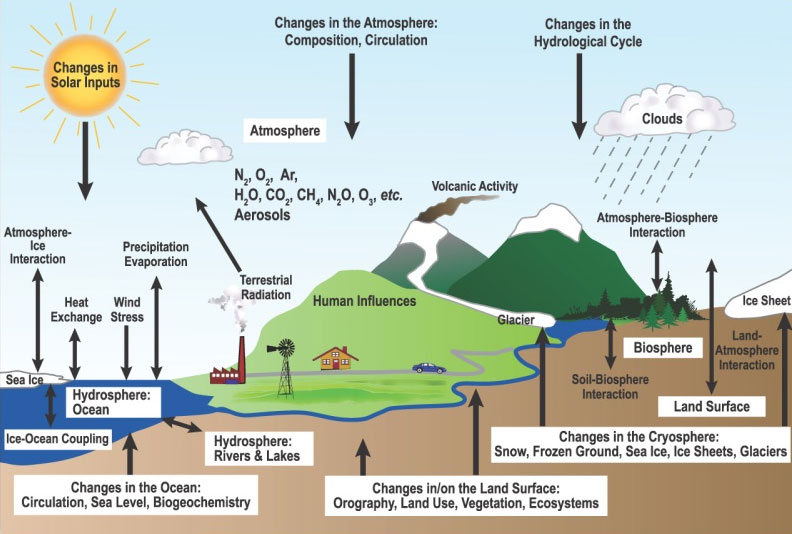Our earth works as a system of four interdependent spheres, namely – lithosphere, hydrosphere, biosphere, and atmosphere. These four spheres of the earth are so closely linked. Almost each of them is affected by any change occurring in any one of the spheres. So, to see and understand the earth as a system it is necessary to understand each sphere individually as well as collectively.
Defining the Four Spheres of Earth
- Lithosphere – The solid outer part of the earth is called the lithosphere. It contains the rigid and rocky crust as well as the brittle upper portion of the mantle.
- Hydrosphere – Total water present on the earth forms its hydrosphere. It includes water in its liquid, solid as well as the gaseous form found on the surface of the earth, underground and in its air.
- Biosphere – The term biosphere relates to all the life present on the earth. It is a narrow zone of earth where land, air and water interact to support life.
- Atmosphere – The blanket of air that surrounds the earth is called its atmosphere. It is the unique atmosphere of the earth that makes it a life-supporting planet.
Interactions between the Four Spheres
Despite having their individual identities each of the four spheres affect others and get affected by events taking place in other spheres.

The interactions among these spheres often occur as a chain reaction in which one interaction leads to other interactions. These interactions lead to the formation of many vital cycles. For example, the water cycle and the carbon cycle, which are important for our existence. Further, understanding these interactions enable us to gauge the extent of damages that can be caused by natural events such as floods and volcano outbursts.
Example 1: Water Cycle
Rain (hydrosphere) falls from the cloud (atmosphere) on to the land (lithosphere) to form water bodies such as rivers and oceans (hydrosphere) which are then used by plants and animals (biosphere).
Example 2: Volcano
Volcanic outburst (lithosphere) emits large quantities of sulfur dioxide (atmosphere) which combines with water droplets (hydrosphere) and falls on earth (lithosphere) as acid rain (hydrosphere). This acid rain leeches into the soil (lithosphere) and water bodies (hydrosphere) and affects plants and animals (biosphere).
The four spheres of earth, as explained above, interact with each other to create the earth’s system.
Use the citation below to add this article to your bibliography
"Earth System Spheres: Layers and Their Interactions." Dashamlav.com. Web. 12 June 2025. <https://dashamlav.com/earth-system-spheres-layers-interactions/>
Dashamlav.com, "Earth System Spheres: Layers and Their Interactions." Accessed 12 June 2025. https://dashamlav.com/earth-system-spheres-layers-interactions/
"Earth System Spheres: Layers and Their Interactions." (n.d.). Dashamlav.com. Retrieved 12 June 2025 from https://dashamlav.com/earth-system-spheres-layers-interactions/
